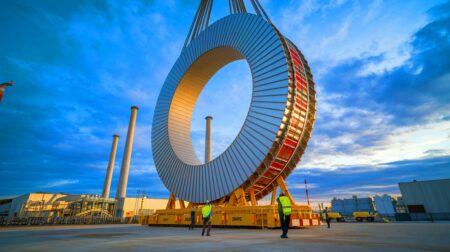| IN A NUTSHELL |
|
The world of nuclear fusion has taken a monumental leap forward, with France’s Tokamak WEST setting a new global record in plasma maintenance. On February 12, the tokamak sustained a plasma state for an unprecedented 22 minutes, surpassing the previous record held by China’s EAST. This remarkable achievement highlights France’s leading role in the race to harness nuclear fusion, a potential game-changer for global energy production. As countries strive to develop sustainable and powerful energy alternatives, the success of Tokamak WEST marks a significant milestone in this quest for the ultimate energy source.
Breaking Records: Tokamak WEST’s Historic Achievement
The Tokamak WEST, located at the French Alternative Energies and Atomic Energy Commission (CEA) in Cadarache, has captivated the scientific community by maintaining a plasma for more than 22 minutes. This groundbreaking feat beats the previous record by 25%, setting a new standard in the field of nuclear fusion. The components of the tokamak, particularly those made of tungsten, have demonstrated remarkable resilience, showcasing the technological prowess required to stabilize fusion plasmas over extended periods.
This accomplishment not only advances our understanding of plasma physics but also paves the way for future reactor development, notably the ambitious ITER project, also hosted in Cadarache. The success of Tokamak WEST is a testament to the meticulous research and dedication of scientists working to make nuclear fusion a viable energy source. By enhancing the duration and stability of plasma states, researchers are one step closer to unlocking the immense potential of fusion energy.
The Role of International Collaboration
Tokamak WEST’s success is part of a broader international effort to advance nuclear fusion technology. Collaborating with major projects like JET in the United Kingdom, JT-60SA in Japan, and EAST in China, this international network underscores the global significance of nuclear fusion as a promising alternative energy source. Such collaboration facilitates the exchange of knowledge and technological advancements, accelerating progress in overcoming the challenges posed by nuclear fusion.
These partnerships are crucial in tackling the most pressing issues in fusion research, such as the limited reserves of tritium, a key fuel in the fusion process. Countries like Italy and the United Kingdom are investing in high-tech centers to address these challenges, ensuring the sustainability of fusion energy for future generations. The collective efforts of these nations highlight the global commitment to achieving a sustainable energy future through nuclear fusion.
Innovations Introduced by Tokamak WEST
Prior to its recent success, Tokamak WEST had already made significant contributions to the field of nuclear fusion. One notable innovation is the exploration of “radiating point-X” plasma scenarios, which optimize the distribution of thermal fluxes and extend the lifespan of tokamak components. This approach is critical in maintaining the structural integrity of the reactor under the intense conditions generated during plasma confinement.
Furthermore, Tokamak WEST has achieved impressive results with its heating systems, injecting 5.8 megawatts through Lower Hybrid heating and over 4 megawatts via ion cyclotron resonance heating. These advancements not only enhance the reactor’s performance but also provide valuable insights into the effective conditioning of tokamak walls, a crucial factor in achieving sustained plasma states. The innovations at Tokamak WEST are paving the way for longer plasma durations and higher temperatures, bringing us closer to practical fusion energy.
The Future of Fusion: France at the Forefront
With the new record set by Tokamak WEST, France is solidifying its position as a leader in nuclear fusion research. The country’s commitment to advancing fusion technology is evident in its support for both WEST and ITER, two of the most prominent projects in the field. These initiatives place France at the heart of the global effort to develop fusion energy, a quest that promises to revolutionize the way we produce electricity.
Despite the challenges that remain, such as the economic viability and infrastructure required for large-scale electricity production, France’s progress in nuclear fusion is a beacon of hope for the future of sustainable energy. As the nation continues to push the boundaries of fusion research, it is poised to play a pivotal role in the energy landscape of tomorrow. Will France’s advancements in nuclear fusion inspire a global shift towards this “miraculous” energy source?
| Project | Location | Objective | Status |
|---|---|---|---|
| ITER | France | Produce 500 MW of fusion power | Under construction, start in 2034 |
| SPARC | United States | Achieve 140 MW near-commercial production | In development, planned for 2026 |
| KSTAR | South Korea | Improve plasma duration for fusion | Set records of 30 seconds in 2022 |
| STEP | United Kingdom | Develop a compact and less costly tokamak | In development for the next decade |
| FAST | Japan | Advance deuterium-tritium fusion | In development with ambitious goals |
As the quest for sustainable energy continues, the remarkable achievements of projects like Tokamak WEST inspire hope and ambition. The advancements in nuclear fusion technology promise a future where clean and abundant energy is within reach. As nations collaborate and push the boundaries of scientific innovation, the question remains: Will nuclear fusion become the cornerstone of our global energy strategy, transforming the way we power our world?
Did you like it? 4.3/5 (26)









Wow, 22 minutes of plasma! That’s like a microwave on steroids. 🔥
How does Tokamak WEST compare in cost to other energy sources?
China just steals and copys so they arent in the competition.
Wow! Congrats to all the engineers who have made this possible!
France is really stepping up! Merci for leading the way in fusion energy! 🇫🇷
Isn’t 2034 a long way off for ITER to start? Hope it doesn’t get delayed further.
I’m skeptical. We’ve been hearing about nuclear fusion for decades!
Great to see international collaboration here. 🌍 How can we ensure it’s equitable?
What’s the deal with tritium reserves? Are they really that limited?
Is France’s success a game-changer, or just another small step?
With all these advancements, does this mean solar power is obsolete?
Big thanks to all the scientists making this possible! 🙌
Are there environmental concerns with nuclear fusion like there are with nuclear fission?
Why is it called Tokamak WEST if it’s in France and not the west? 🤔
This is why we need to invest more in science and technology. Kudos to France!
Can someone explain “radiating point-X” plasma scenarios in simpler terms?
When will this technology be available to the general public?
How does France’s fusion research impact global energy strategies?
Hope this isn’t just another hype like cold fusion.
ITER’s 500 MW goal is impressive. Is that enough to power a city?
What are the potential risks associated with nuclear fusion?
Finally, some good news in the energy sector! 🚀
How much more funding is needed to make fusion energy viable?
Plasma for 22 minutes? Let’s aim for 22 hours! 💪
Is Tokamak WEST more advanced than China’s EAST now?
Just curious, how do they actually “contain” the plasma?
Hope this doesn’t lead to a new kind of nuclear arms race… 🤨
Keep pushing the boundaries, France! The world is watching. 🌟
22 minutes? Sounds like a good start but we need hours, not minutes, right?
So, when can we expect our electric bills to go down? 😅